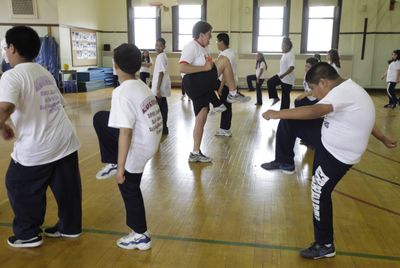Bigger kids, but fewer P.E. classes
Schools fail to require enough exercise, and test push a factor

CHICAGO – The gym at Eberhart Elementary School is bright and spacious – with high ceilings, several basketball hoops, even a large, colorful climbing wall.
But for much of the day, the gym doubles as a cafeteria where the school’s 1,800-plus students are offered breakfast and lunch.
There’s another gym on the fourth floor, but it’s so old it has basketball hoops attached to ladders. Time and space limitations mean each class gets physical education just once a week for 40 minutes.
In the fight against childhood obesity, getting kids moving is one of the most effective ways to combat the problem. But only Illinois and Massachusetts require P.E. classes for all kids in kindergarten through 12th grade. And, as Eberhart’s example shows, even those requirements sometimes are not enough.
“I understand the funding issue. I understand the space issue,” said Betty Hale, one of two P.E. teachers at Eberhart. But “our children are getting shortchanged.”
Illinois first adopted P.E. requirements in 1915, and the state has been mandating phys ed for all grades since 1957. But those rules have not prevented kids from getting heavier. An estimated 20.7 percent of 10- to 17-year-olds in Illinois are obese, according to a 2007 survey released last month by the Child and Adolescent Health Measurement Initiative. That’s fourth-highest in the country, behind only Mississippi, Georgia and Kentucky.
Nationwide, an estimated 32 percent of American kids ages 2 to 19 are overweight, including 17 percent who are obese, according to the Centers for Disease Control.
Illinois mandates gym class but does not have a standardized P.E. curriculum, meaning what counts can vary widely. Kids at Eberhart play kickball once a week in a cluttered, 100-year-old gym. Meanwhile, students in suburban Niles are high jumping in a gym that includes a weight room.
The state does not monitor schools to ensure they are meeting the daily requirement, and there are no penalties. Waivers are available to districts that have financial issues or want more classroom time.
Health experts recommend 30 minutes of daily physical education for elementary school students, and 45 minutes for those in junior high and high school.
But in a recent CDC study, less than 4 percent of elementary schools, less than 8 percent of middle schools and just over 2 percent of high schools required daily P.E. for all students for the entire school year.
With annual math and reading tests, many schools are trying to find extra teaching time. But doing it at the expense of physical education is misguided, said Russell Pate, at the University of South Carolina.
“I’m all for holding schools to high standards with regard to academic outcomes,” Pate said. “But we need to have some balance. We need our schools to be healthy places for kids.”